Digital Dangers and Physical Threats:
Identifying Key Intervention Points in School Bullying Patterns
In a time marked by dynamic shifts in education and learning environments, as well as challenging political and social climates, understanding parental perspectives on their children’s schooling and safety is pivotal. With the educational landscape undergoing rapid transformations, fueled by technological advancements, policy reforms, and societal changes, parental voices serve as invaluable guides in navigating the complexities of modern schooling.
A pilot survey was conducted — by Stop School Violence, Inc / Interectional Equity Maricopa — with 100 respondents who were parents of school-aged children across the United States.
The pilot survey sought to capture a diverse array of parental viewpoints, encompassing various demographic backgrounds, geographic locations, and educational contexts. By canvassing opinions on topics ranging from curriculum preferences to perceptions of school safety, the survey aimed to provide a nuanced understanding of the challenges, aspirations, and priorities shaping parental involvement in their children’s education.
This report endeavors to shed light on key trends, disparities, and emerging themes in parental perspectives across the United States. By illuminating the intricate dynamics between parents, students, and educational institutions, this analysis endeavors to inform stakeholders, policymakers, and educators in their endeavors to create more equitable, responsive, and safe learning environments for all children.
Survey Analysis
The data on bullying in schools provides valuable insights into the prevalence, types, and perceptions of bullying among students.
The analysis reveals that the most common types of bullying reported include verbal and social bullying, followed by cyberbullying.
The primary reasons for bullying are related to appearance, social status, and perceived differences.
The severity of bullying is perceived to be a significant problem by a majority of respondents, with a belief that it has worsened over time.
Additionally, there is a notable difference in severity perception between respondents’ own schools and other schools nationwide, indicating that individuals tend to view bullying as a more severe issue outside of their immediate school environment.
These findings highlight the need for continued efforts to address and prevent bullying in schools to create safer and more inclusive learning environments for all students.
Respondent Demographics
The respondent demographics breakdown reveals key insights into the individuals participating in the survey.
The majority of respondents are parents of high school students, followed by middle school students.
The sample includes a relatively equal representation male and female participants, ensuring a balanced perspective on the issue of bullying.
In terms of geographical distribution, the respondents come from various states across the country, providing a comprehensive view of bullying experiences and perceptions in different regions.
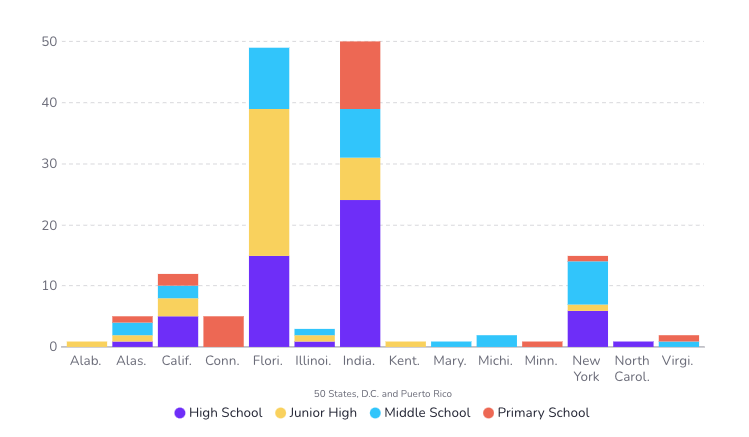
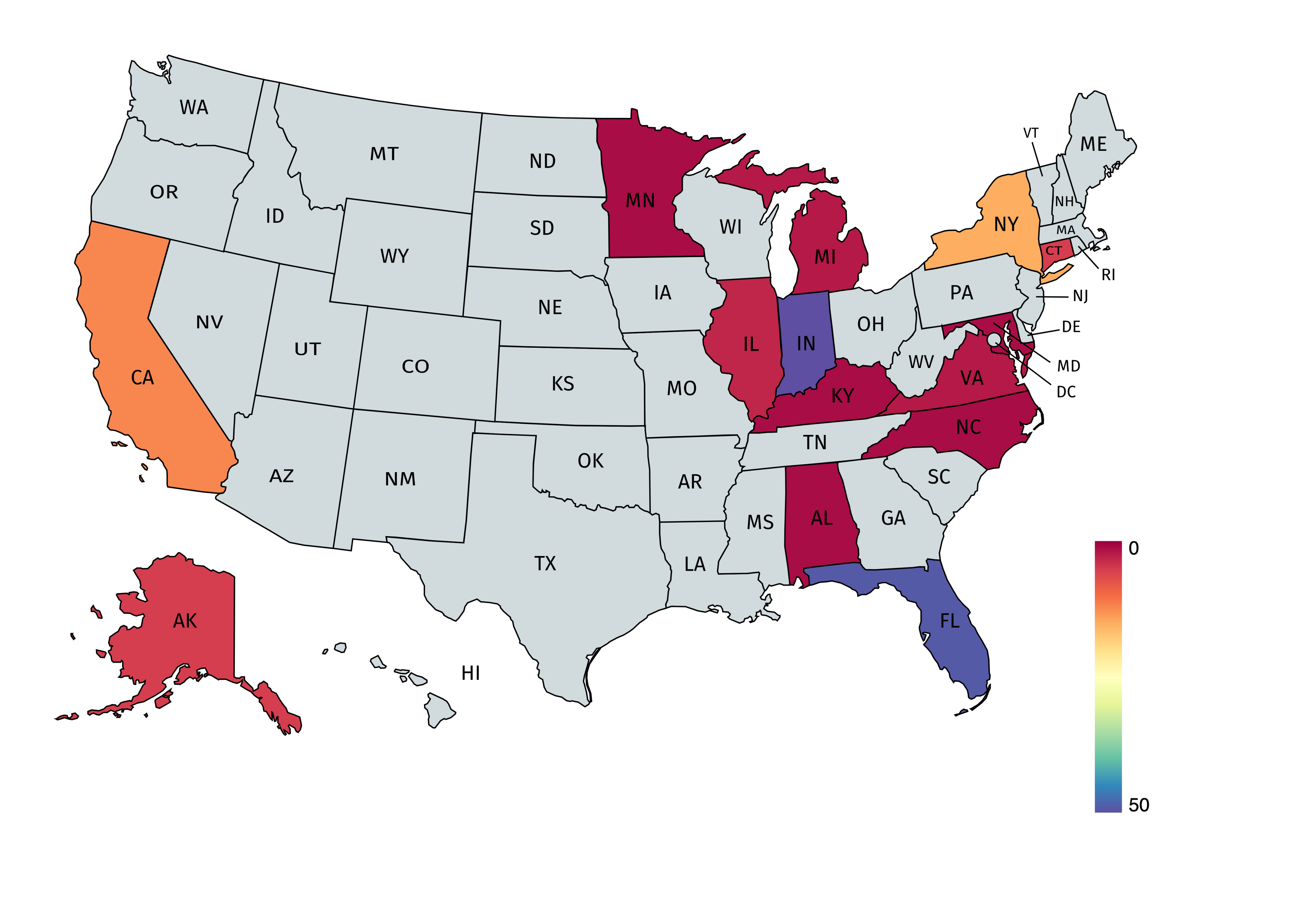
Key Datapoints & Insights
Bullying Experience:
Percentage of parents of children who experienced bullying: 76{4a69b362dd93a6614faf85c52b9015285f559d111cd601458465c7420b0c0def}
Types of Bullying by School Level:
- Elementary School students appear to experience a combination of in-person physical and verbal bullying, with a lesser incidence of online/cyberbullying.
- Middle School students also report a mix of in-person physical and verbal bullying, similar to elementary school, with a small number of instances of online/cyberbullying.
High School students reported a higher occurrence of in-person verbal bullying compared to the other types, with similar levels of in-person physical bullying and online/cyberbullying.
- Experienced School Bullyinh 76%
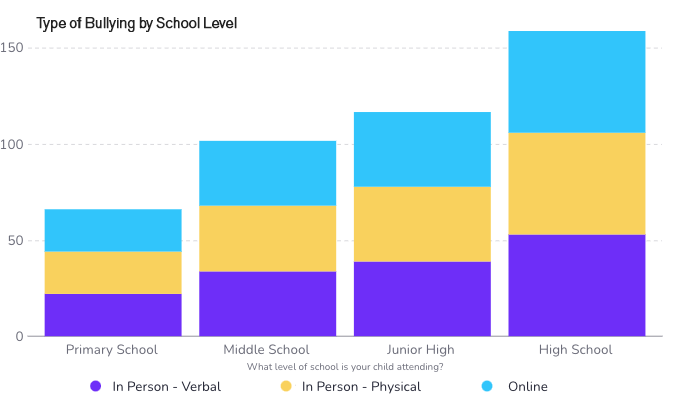
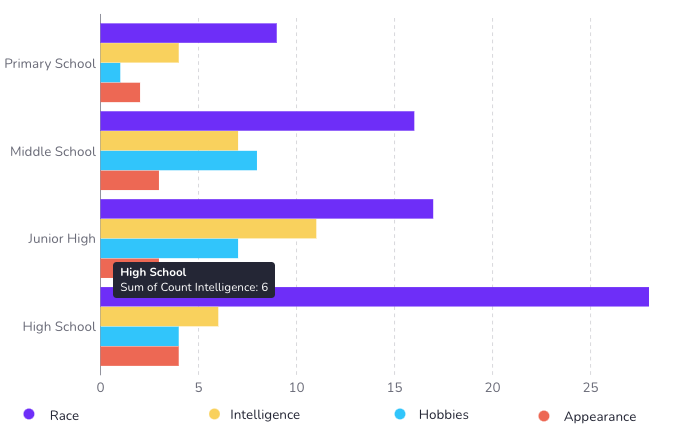
Findings & Potential Implications
Relationships
Verbal Bullying + Appearance: Verbal bullying related to a person’s physical appearance, such as body shape, size, or facial features, is a common combination.
Verbal Bullying + Personal Traits: Verbal bullying targeting personal traits, such as personality, character, or individual quirks, is another common combination.
Verbal Bullying + Intelligence/Academic Abilities: Verbal bullying related to intelligence or academic abilities is also a common combination, where individuals may be targeted based on their intellectual capabilities or performance in school. Cyberbullying is perceived as a potentially severe issue.
Cyberbullying + Online Behavior: Cyberbullying, which takes place through digital platforms, commonly involves targeting someone based on their online behavior, such as posting comments, sharing content, or participating in online communities.
Cyberbullying + Anonymity: Cyberbullying often utilizes the anonymity provided by online platforms, allowing individuals to target others without revealing their identity.
Physical Bullying + Differences: Physical bullying often occurs due to perceived differences in physical attributes, such as height, weight, or physical abilities.
Social Bullying + Peer Pressure: Social bullying frequently involves exerting peer pressure on individuals to conform to certain behaviors, beliefs, or group norms, resulting in exclusion or isolation.
Social Bullying + Social Status: Social bullying, which involves manipulating social relationships and status, often occurs based on a person’s popularity, social skills, or perceived social standing.
Influencing Factors
Age: Older individuals tend to perceive bullying as a more severe problem and believe that it has gotten worse compared to younger individuals. This could be due to their accumulated life experiences and exposure to different social contexts.
Personal Experience: Individuals who have personally experienced bullying or witnessed it firsthand are more likely to view bullying as a severe problem that has worsened. Their direct encounters with bullying may influence their perception and understanding of its impact.
Location: People living in urban areas tend to perceive bullying as a more severe problem and believe it has worsened compared to those in rural areas. Urban environments often have more diverse populations, increased social interactions, and higher exposure to technology, which may contribute to a higher prevalence of bullying incidents.
Education Level: Higher levels of education are generally associated with a greater awareness of social issues, including bullying. Therefore, individuals with higher education levels are more likely to perceive bullying as a severe problem and believe it has increased over time
Empathy and Sensitivity: Individuals who exhibit higher levels of empathy and sensitivity towards others are more likely to view bullying as a severe problem and believe that it has worsened. They may be more attuned to the emotional and psychological impact of bullying on victims, leading to a stronger perception of its severity.
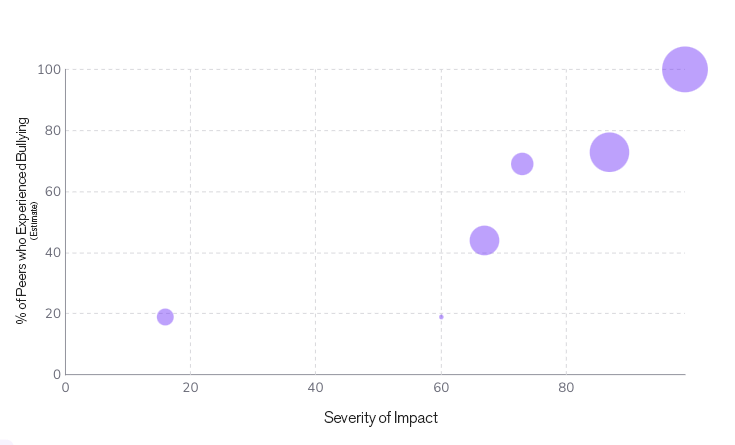
Own School Perception: The data suggests that individuals tend to perceive bullying in their own school as more severe compared to all schools collectively. This could be because individuals have a more direct and personal experience with bullying incidents within their own school environment, making it feel more immediate and impactful to them.
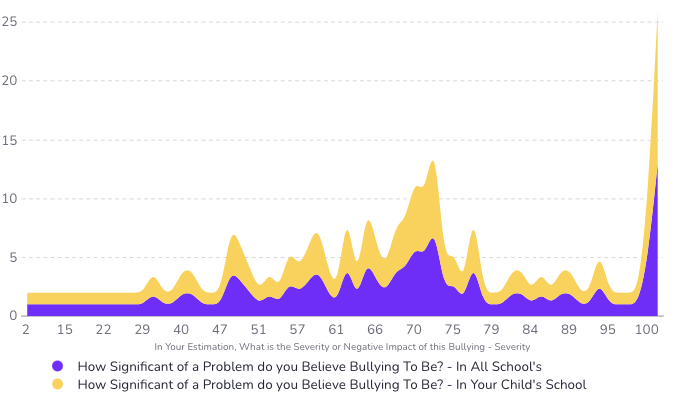
Limited Perspective: When considering their own school, individuals may have a limited perspective and be more aware of the specific bullying incidents that occur within their immediate social circle or community. This narrow focus can amplify the perception of severity, as they have firsthand knowledge of the specific cases within their own school.
Localized Factors: Perception of severity in one’s own school may be influenced by localized factors such as the school’s culture, community dynamics, and individual experiences within that particular environment. These factors can contribute to a heightened sense of severity within the immediate context of one’s own school.
Generalized Perception: On the other hand, when individuals consider all schools collectively, they may have a more generalized perception of bullying. This broader perspective may take into account a wider range of schools, including those with varying degrees of bullying incidents and severity. As a result, the perception of severity may be tempered when considering the overall picture across all schools.
Media Influence: Individuals who consume more media, especially news and reports on bullying incidents, are more likely to believe that bullying is a severe problem and that it has worsened. Media coverage can raise awareness and contribute to the perception that bullying is a growing issue.The perception of severity in one’s own school may be influenced by media coverage and personal exposure to local incidents of bullying. Media often highlights specific cases of bullying, which can contribute to the perception that bullying is more severe within one’s own school. This exposure may not be as prevalent when considering all schools collectively, leading to a different perception.
Addtitional Research, Outreach, and Intervention to come @ StopSchoolBullying.org

